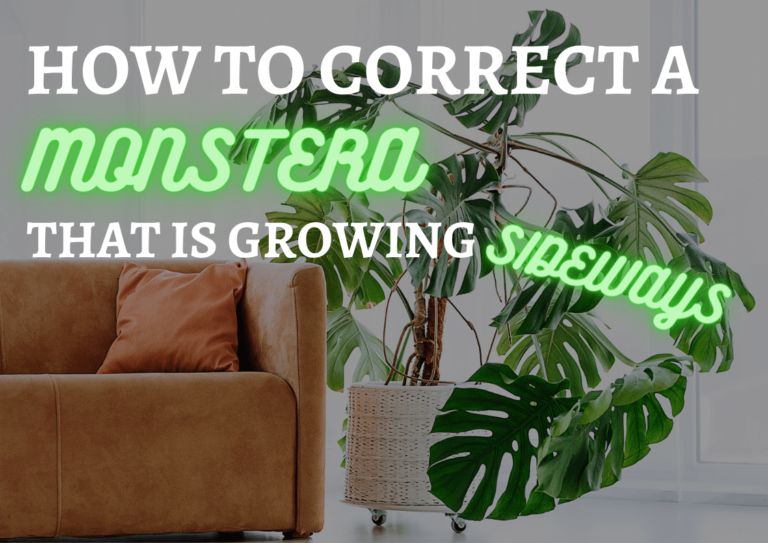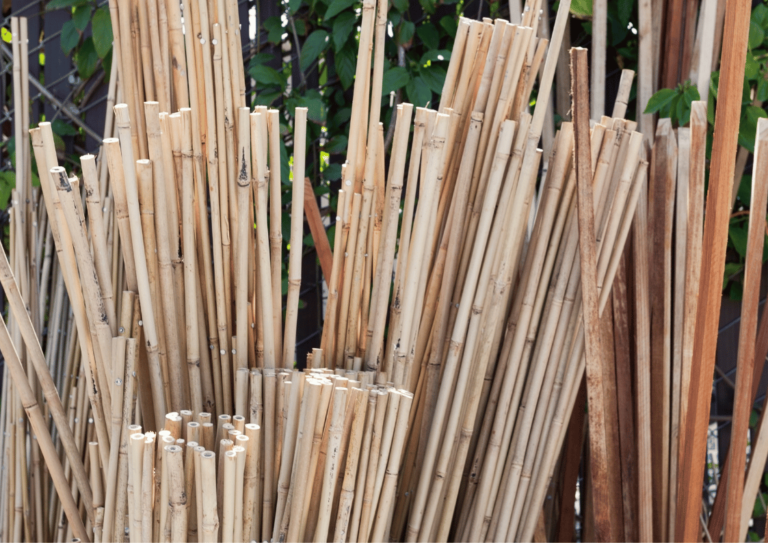How To Correct A Monstera That Is Growing Sideways
-
Chris Dosser
- May 27, 2023
If you buy something using the retail links in our articles, sometimes we earn a small affiliate commission. This does not impact the products we recommend.
The Monstera genus is one filled with climbing plants. These plants do not have the features necessary to support themselves because, in the wild they tend to use their aerial roots to wrap around larger plants or cling onto tree bark to keep themselves upright.
When kept as houseplants and away from their natural environment, Monstera don’t have anything to support their climbing tendencies. This can cause them to flop over and grow sideways until their large leaves trail across the floor! This is pretty invasive and takes up a lot of space, and even if you like this aesthetic it can leave your plant susceptible to damage.
Monstera plants that grow sideways can be corrected with garden stakes, moss poles or even a trellis. Various other materials, such as bamboo sticks, can be used on young plants, but these are not as useful as mature specimens do get rather heavy and need a sturdier support mechanism. At the end of the day what matters is that the plant is offered something which it can climb vertically to support itself.

A garden stake is likely your best bet if your Monstera has already reached a point of overgrowth. Gently guiding stems to where you want the plant to go and tying them in place loosely with twine can be easily done at this point without fear of damage occurring.
How do I use a garden stake to correct a Monstera that is growing sideways?
Garden stakes are probably the simplest, easiest, and most inexpensive way to correct a Monstera’s growth. A basic, strong garden stake can be driven into the soil and used by a Monstera as a supportive and sturdy item to climb. Monstera plants naturally gravitate toward a structure that offers vertical support and can straighten themselves out on their own.
Stakes aren’t very complicated and can be used with ease. Their primary downside is that they do stand out and can ruin the overall aesthetic of your Monstera’s lush appearance.
The best time to add a stake to your Monstera’s pot is during the repotting process. Sticking a stake into a pot that’s filled to the brim with densely packed roots can be risky. As such, if you want to add a stake but don’t want to repot, you’ll want to use a trowel to check for a safe place to put the stake. Make sure you place the stake deep into the soil
Some people prefer to stake the center of the pot, as this is the direction the plant will grow in and cling to. However, you can also add support on the pot’s edges and use multiple stakes to give your Monstera more space to grow. If you’re careful, you can always add additional support stakes as your Monstera requires them over the months and years.
To attach the Monstera to its support, you can use garden twine or plant wire to wrap larger stems to the stake. If your plant has several aerial roots, you can instead simply take these roots and wrap them around the stake if you prefer. New growth that develops after support is added should be attached to the stake, so it grows correctly.

How do I use a trellis to correct a Monstera that is growing sideways?
If you have the space and your Monstera is still relatively young, a trellis is a great way to display and grow a Monstera plant. A trellis can help the plant to train its growth in one neat area, and it’s a secure way to display a plant in a unique and beautiful way.
The best trellis to use for a Monstera plant is one with multiple poles. Some trellises can be weak, so ensure you choose a strong one. Remember that Monstera plants can grow tremendously and hit ten-foot heights even indoors. That’s a lot of weight for a trellis to support, so make sure you really choose a strong one with enough space for such growth!
The right trellis for a Monstera plant will allow it to spread out and grow thick, lush, and verdant instead of only causing the plant to cling to one or two areas. With that being said, do keep in mind that a trellis is not flexible. As such, a Monstera that is already half- or fully-grown will not be able to be reshaped to the rigid shape of a trellis.
Our Favorite Monstera Plants And Supplies On Etsy
How do I use a stick or pole to correct a Monstera that is growing sideways?
If you’re partial to something akin to a garden stake but want something a little higher in quality or that looks a little more aesthetically pleasing, plenty of sticks and poles are available. A moss stick, specifically a coco coir pole can be a good alternative.
Sphagnum moss sticks are great options because they provide Monstera plants with a surface similar to that which they would encounter in the wild, such as tree trunks or rocks. They can also provide water and micronutrients to a Monstera that it can consume using its aerial climbing roots.
Monstera plants naturally root themselves in damp, natural substances, as they would do on the lichen and moss of trees in rainforests. All you have to do is buy a strong enough moss stick to support a Monstera and its growth. It’s recommended that you use more than one. Ensure the sticks are placed evenly, so your Monstera grows in the direction you want.
If you prefer a more “natural” appearance that blends in with your Monstera aesthetically, you can also opt for a coco coir pole, which provides all the same benefits to your plant, both health-wise and support-wise.
You can attach a Monstera to a stick or pole of this variety in the exact same way as a stake. Do it when repotting, if possible, and be careful not to damage any roots. The upside of these more “natural” poles is that a Monstera is more likely to cling to a pole or stick of moss or coco coir without needing to be artificially attached.
How can I prevent sideways growth in a Monstera?
Pruning a Monstera is one of the most important steps in preventing sideways growth in this plant. Monsteras grow extremely quickly, get leggy, and grow poorly when not given a regular trim. Even if you don’t mind some sideways growth, pruning is still important to a Monstera’s health.
If you don’t want to use stakes, sticks, or a trellis, pruning can help keep your Monstera straight. Just cut back the excess leaves, pulling the plant in the wrong direction. Do this carefully and follow a clear guide on correct, prudent pruning to avoid damaging your foliage.
You can also influence your Monstera to grow in a specific direction by changing the direction of its light source. Monsteras will always grow toward the light, so rotating pots on a regular basis can encourage balanced growth.
Lastly, if your Monstera is only slightly imbalanced, repotting the plant and rotating the root ball to be more upright can help to correct the current problem. As long as all roots are correctly buried and potted beneath soil, this is a safe practice.
Take home message
It’s fairly easy to correct sideways growth in a Monstera plant. Simply use a garden stake or a coco coir pole and encourage the plant to use them as support. Young Monstera plants can also be trained to grow well on a trellis.
It’s to be expected that your Monstera needs support to grow straight, as it is a climbing plant that only has thin stems and is meant to adhere to sturdier plants in the wild. You can prevent the problem with regular pruning, careful balance of light exposure, and repotting when necessary.

Chris Dosser
Co-Founder of Eden Indoors
Chris is a self-taught horticulturist with over a decade of experience caring for houseplants and creating lush, thriving indoor oases. He specializes in Monstera, and by self admission has a serious problem with buying and propagating rare indoor plants!
Similar Posts
Winterizing Your Monstera: Protecting Your Plant from Cold Damage
Monstera kept in chilly climates are susceptible to cold damage if not protected from the deep freeze. Here's some tips to winterize your precious fenestrated foliage.
The Best Fertilizer for Monstera Plants: Effective Usage Tips
This guide will help you choose the optimal fertilizer for your Monstera so as to help maximize the plant's health and increase foliage production.



